India is a vibrant country with a diverse mix of traditional and modern cultures. Coming to India, you can immerse yourself in sun-drenched beaches, visit national parks or explore interesting wildlife reserves. From massive forts to serene beaches to stately mosques, visitors to India will be greeted with a wealth of spiritual, cultural and historical treasures. Traveling to India is definitely an option worth considering, let's explore the list of Top 10 tourist attractions not to be missed in India.
1 Taj Mahal, Agra
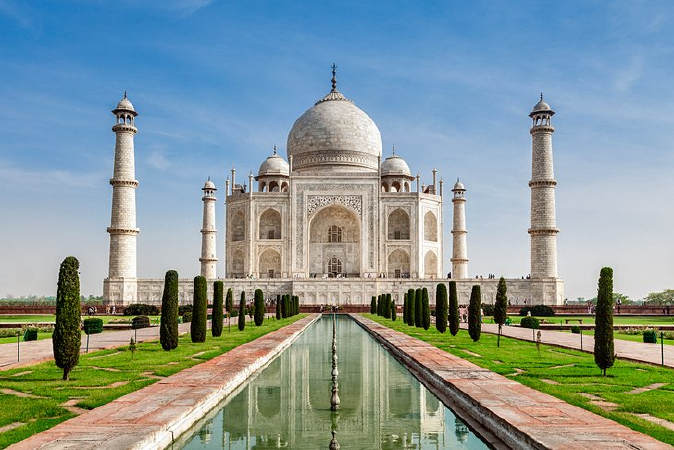
The Taj Mahal, Agra is the world's most famous demonstration of the power of love (Image: planetware)
Perhaps India's most recognizable building, the Taj Mahal is also the world's most famous demonstration of the power of love. Named after Mumtaz Mahal, favorite wife of Emperor Shah Jahan, this most beautiful mausoleum was started construction after her death in 1631 and took 20,000 workers until 1648 to complete.
Incorporating many elements of Islamic design including domes, minarets, onion domes and black calligraphy inlaid around the entrance, the Taj Mahal is largely constructed of white marble. Adding to its splendor are intricately inlaid floral motifs and precious and semi-precious stones such as sapphires, sapphires, diamonds and mother-of-pearl.
The best time to visit is at dawn or dusk when the atmosphere is brilliantly changed by the changing light. If possible, try to see the reflection of the Taj Mahal from the far bank of the Yamuna River - it makes for a memorable (and safe) selfie.
2 The Holy Land of Varanasi

Varanasi is one of the oldest still inhabited cities in the world (Image: planetware)
Dating back to the 8th century BC, Varanasi is one of the oldest still inhabited cities in the world. A major pilgrimage center for Hindus, this holy city has long been associated with the mighty Ganges River, one of the faith's most important religious symbols.
Varanasi offers many reasons to visit, especially the chance to explore the Old Town adjacent to the Ganges River, where you'll find Kashi Vishwanath Temple, built in 1780. New Vishwanath Temple with seven separate temples is also very interesting.
Bathing in the Ganges is of great importance to Hindus, and many sites known as "ghats" have stairs leading to a stream where devotees bathe before praying. The largest are the Dasashvamedh Ghat and the Assi Ghat. The latter, at the confluence of the Ganges and Asi rivers, is considered particularly sacred.
Also worth seeing is Banaras Hindu University, founded in 1917 and famous for its massive library of over a million books and the excellent Bharat Kala Bhavan museum with its superb collections of miniature paintings. , sculptures, palm leaf manuscripts and local history exhibits.
3 Harmandir Sahib: Amritsar's Golden Temple

Harmandir Sahib: Amritsar's Golden Temple (Image: planetware)
Founded in 1577 by Ram Das, Amritsar is an important center of Sikh history and culture. The main attraction here is the Harmandir Sahib, which opened in 1604 and is still commonly known as the Golden Temple because of its beautiful gold decoration.
The holiest of India's many Sikh temples (it also attracts many Hindus and other followers), the temple is built in a mixed Hindu and Buddhist style. Islam. Its marble bottom features ornate floral and animal motifs, while the large golden dome represents the lotus, a symbol of purity for Sikhs.
In addition to its splendid design, visitors are equally impressed by the temple's spiritual atmosphere, an effect enhanced by the constant prayers chanted from the holy book of Sikhism and delivered. throughout the complex.
Part of the overall experience - and visitors are welcome to join - is the chance to enjoy one of the 50,000 free meals the attraction serves to visitors each day.
4 Golden City: Jaisalmer
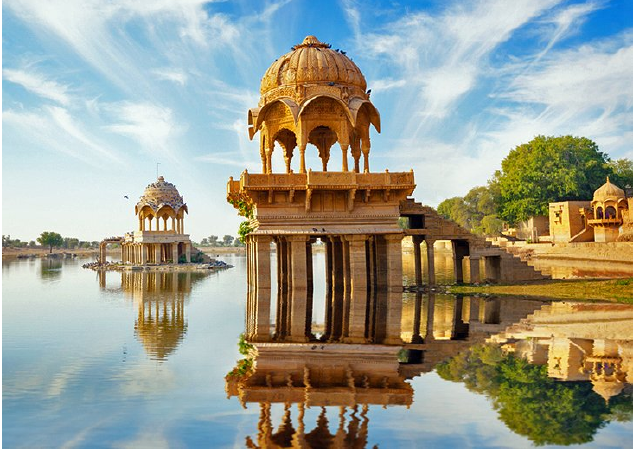
Jaisalmer's Golden City is an oasis of splendid ancient architecture (Image: planetware)
Named for the yellow sandstone used in most of its buildings, Jaisalmer's Golden City is an oasis of splendid ancient architecture rising from the dunes of the Thar desert. Once a strategic outpost, today the city is filled with splendid old mansions; palatial gates; and the massive Jaisalmer Fort, also known as the Golden Fort, a fearsome 12th-century structure perched high above the town.
In addition to its beautiful palaces, temples, and old houses, the fort has 99 bastions along with large gates leading to the main courtyard, where you'll find the seven-story Maharaja Palace. Started in the early 1500s and added by successive rulers until the 19th century, the palace offers areas open to the public, including beautifully decorated areas in brick. from Italy and China, and intricately carved stone doors.
There are also several Jain temples dating from the 12th to 16th centuries, each decorated with marble and fine sandstone images, palm leaf manuscripts, and brightly painted ceilings. Be sure to check out the well-preserved 1,000-year-old library, Gyan Bhandar, with its many 16th-century manuscripts and artifacts.
5 Red Fort, New Delhi
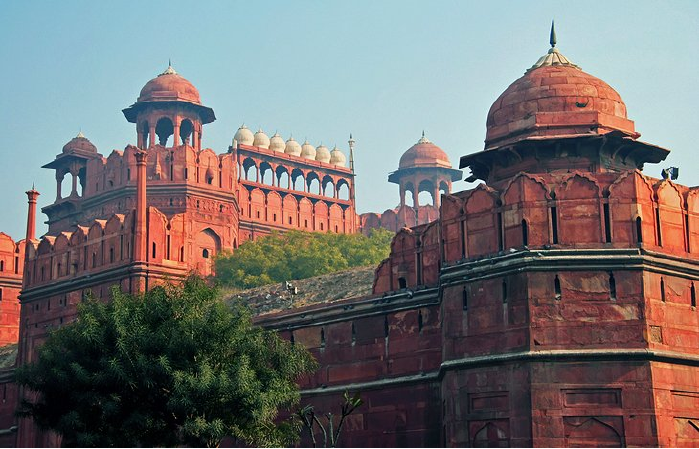
The magnificent crescent-shaped Red Fort in New Delhi, named after the beautiful red sandstone (Image: planetware)
Built by Shah Jahan in 1648 as the seat of Mughal power - a role it maintained until 1857 - New Delhi's magnificent crescent-shaped Red Fort, named for its red sandstone Beautiful buildings were used in its construction, covering a large area of more than two square kilometers, all surrounded by a large moat.
Highlights include its two largest gates: the impressive Lahore Gate (the main entrance to the fort) and the ornate Delhi Gate, once used by the emperor for palanquin ceremonies.
Part of the fun of a visit is exploring Chatta Chowk, a 17th-century covered market that sells everything from jewelry to silk garments as well as souvenirs and food. While you can explore the fort on your own, guided tours are offered and provide fascinating insight into the life and times of the Shah, including a look into the Reception Hall beautiful white marble public (Diwan-i-Am), where he received his subjects.
6 Mumbai: Gateway to India
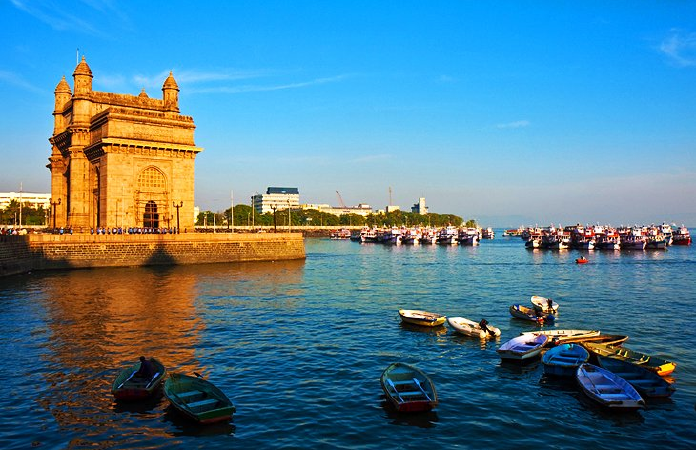
Mumbai: The Gateway to India was built to commemorate the arrival of King George V and his wife Queen Mary (Image: planetware)
With an impressive height of 26 meters and overlooking the Arabian Sea, the iconic Gate of India is a must-see when visiting Mumbai. Built to commemorate the arrival of King George V and his wife Queen Mary in 1911, this beautiful structure was opened with much solemnity and ceremony in 1924 and for a time. space, is the tallest structure in the city.
Built entirely of yellow basalt and concrete and featuring an Indo-Saracenic design, the Gateway of India was also the site of a rather less jubilant procession of British soldiers in 1948 when India gained independence. . Today, the huge archway provides a beautiful setting that is loved by locals and tourists alike.
Hot Tip: After visiting the Gateway to India, stop by the Palace and the adjacent Taj Mahal for a delicious High Tea, a fun thing to do in Mumbai since this lovely luxury hotel opened in 1903.
7 Mecca Masjid, Hyderabad
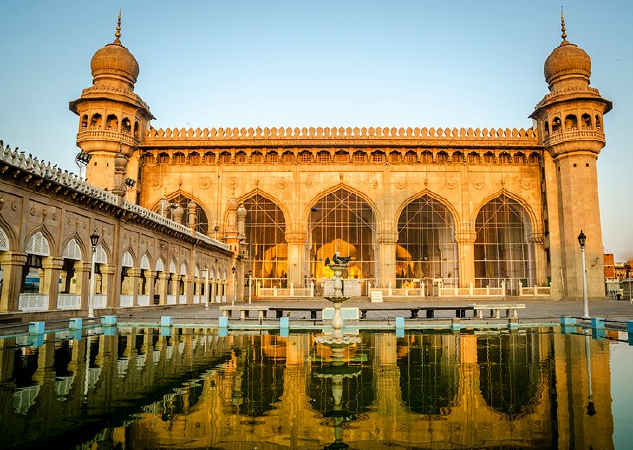
Mecca Masjid, Hyderabad is one of the largest mosques in the world (Image: planetware)
Construction of Hyderabad's Mecca Masjid, one of the largest mosques in the world - and one of the oldest in India - began in 1614 during the reign of Mohammed Quli Qutub Shah and took nearly 80 years to complete.
Large enough to hold 10,000 worshipers, this mosque's 15 massive domes and pillars were all forged from single slabs of black granite that were towed to the site by massive cattle trains believed to include up to 1,400 bulls.
Taking its name from the bricks above the central gate brought here from Mecca, this impressive complex features such highlights as the main gate, a grand square and a large man-made pond. There is also a room containing the hair of the Prophet Mohammed.
Other notable features include the inscriptions from the Quran above the many domes and doors, the delicate roof of the main hall, and the moldings around the entire structure of the mosque. teacher. Notice the delicate floral motifs and ruffles on the domes.
8 Amer Fort, Jaipur
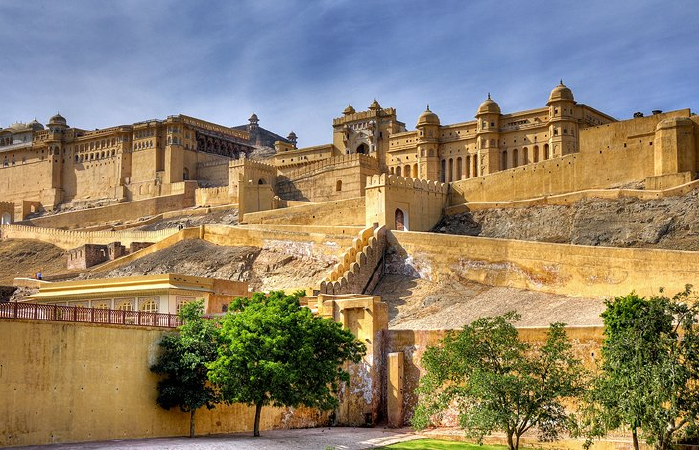
You can walk to the fort by climbing the slopes or take the shuttle from the town below (Image: planetware)
Amer Fort (also commonly spelled "Amber") was built as a fortified palace in 1592 by Maharaja Man Singh I and has long been the capital of Jaipur. Carved high into the hillside, you can walk to the fort by uphill or take the shuttle from the town below (better yet, let an elephant do the job).
Highlights include Jaleb Chowk, the first courtyard, with its many decorated elephants, and the Shila Devi Temple, dedicated to the goddess of war. Also of note is the Adjacent Public Audience Hall (Diwan-i-Am) with its finely decorated walls and terrace frequented by monkeys.
Other highlights include the Sukh Niwas (Lobby of Joy) with its many flower beds and a canal once used to conduct cooling water, and the Temple of Victory (Jai Mandir), notable for its many decorative panels. , colorful ceilings and great views of the palace and lake below.
Just above Amer Fort is Jaigarh Fort, built in 1726 by Jai Singh and featuring tall towers, formidable walls and the world's largest wheeled cannon. Be sure to also spend time wandering the walled Old City of Jaipur with its three fully restored gates and splendid markets, as well as the delightful City Palace, a massive complex consisting of including courtyards, gardens and buildings.
9 Goa's beaches

Palm-lined beach in Goa (Image: planetware)
Long known in India as a "must-visit" destination for those looking for a great beach vacation, Goa's beautiful west coast, overlooking the Arabian Sea, has only recently been visited by foreign tourists. beyond recent discovery. Goa's more than 60-mile coastline is home to some of the most beautiful beaches in the world, each with its own charm.
For those looking for peace and quiet, isolated Agonda Beach is a good choice, while Calangute Beach is by far the most commercial and crowded. For those looking for luxury resorts, yoga getaways and spa vacations, the beaches of Mandrem, Morjim and Ashwem are fashionable among wealthy Indians as well as Westerners. Palolem is one of Goa's other popular beaches with stunning views.
Khi ở Goa, hãy nhớ ghé thăm Khu bảo tồn Động vật Hoang dã Bhagwan Mahavir . Điểm tham quan tuyệt vời này là nơi có những khu rừng rậm và nhiều loài động vật, bao gồm hươu, nai, khỉ, voi, báo, hổ và báo đen, cũng như rắn hổ mang chúa nổi tiếng của Ấn Độ và khoảng 200 loài chim.
Cũng đáng ghé thăm là Đảo Divar , đến bằng phà từ Old Goa. Các điểm nổi bật bao gồm Piedade , một ngôi làng Goan điển hình và là nơi có Nhà thờ Đức Mẹ Từ bi với tác phẩm vữa thú vị, đồ trang trí bằng thạch cao Baroque và bàn thờ, cũng như tầm nhìn tuyệt đẹp ra vùng nông thôn xung quanh.
10 Periyar National Park and Wildlife Sanctuary, Madurai

Periyar National Park and Wildlife Sanctuary is located around a lake (Image: planetware)
One of South India's most popular tourist attractions, Periyar National Park and Wildlife Sanctuary sits around a lake built in 1895 by British engineers for irrigation and provides water to the city of Madurai.
Established in 1934, this beautiful park is home to a variety of mammal species, including a large population of free-range Indian elephants, wild boar, otters, macaques and more than 20. Bengal tiger. Bird watching is a popular activity with regular sightings of warblers, storks, kingfishers, hornbills and rattlesnakes, along with a variety of interesting butterflies.
The best way to enjoy the park's splendid mountain views is by taking a lake cruise or a guided forest walk, the latter of which allows visitors the chance to come face to face with elephants and observe the elephants. other wildlife species from watchtowers and observatories.
Hot Tip: Be sure to stop by one of the many nearby spice, tea or coffee plantations for a tour.

